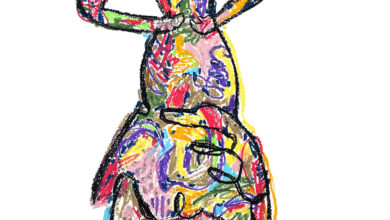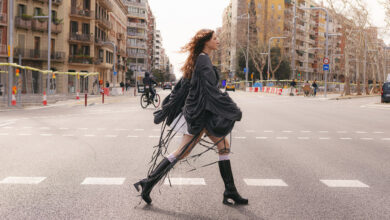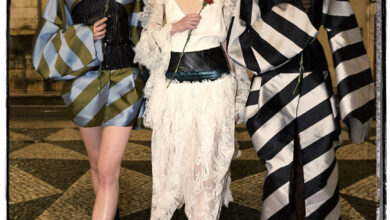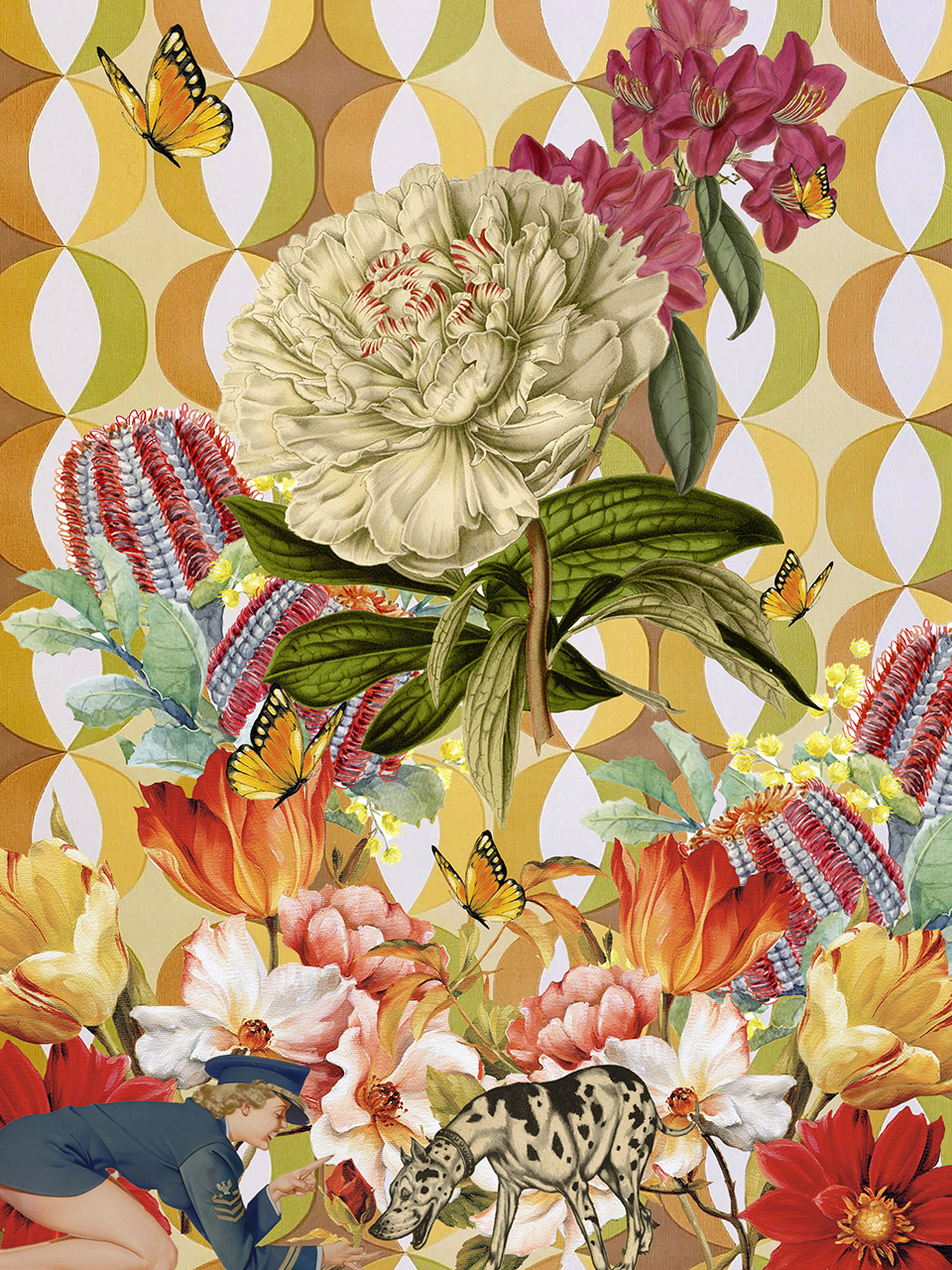
Photography and illustrations by GL Wood
Hair Sokina Hamreabaeva
Make-up Gilbert Stoliz
Styling Larry Goodworld and WOLFEYES
Creative Agency Factory 311
Talents Amelia Kearney and Lura Normand at TWO Management Los Angeles
Words and interview by Michaela Doyle
Vintage paper dolls, pinup postcards, scrap books, sticker albums and 1970s wallpaper: these are the touchstones that strike a nostalgic chord in GL Wood’s fashion compositions. Upon first glance, you might not be able to tell the finished product is a result of a painstaking process, with the clothing and the model photographed separately and then made whole through collage. But look closer into GL’s fantasy world, and you’ll see hints of unreality that resist definition.
When our editor-in-chief first saw GL Wood’s collection of images, they transported her to her childhood in Germany and her favorite pastime of decorating “poesiealbums” with her friends. One of our interns from Portugal couldn’t stop thinking of the film Alice Through the Looking Glass. And for me, growing up in the US, I was brought back my sticker albums and Lisa Frank binders. GL’s aesthetic evokes a modern nostalgia that resonates across cultures and ages. With the layering of manual and digital techniques, the compositions appear quite flat—often lacking shadow where our brains expect it—but the feelings they evoke are vibrant and full of curiosities that pull at your heart.
After having started his photography career in the music world, GL was drawn to the process and collaborative nature of fashion photography. He saw it as an area where he could really push the boundaries and come up with his own way of working.
My circle of friends was a bunch of rocker kids, and we were focused on music and getting into trouble. The draw to fashion happened when I learn that you can be much more experimental and artistic with the images, makeup, hair, styling and lighting. It seemed that the [fashion] industry was much more acceptable of the creativity. I also loved the fact that you need to work with a team, collaborating on the concept. Shooting a band was a very lone wolf type of shooting. I enjoy the whole process of idea concept to finished product side of fashion.
— GL Wood
For this project, as with most of his work, the team was key. The styling was done remotely by Larry Goodworld, who took photos of the looks on a mannequin at different angles, with lighting predefined by GL. The hair and make up team worked on the models in the studio and photographed them without the clothing. Once all the pieces were gathered, GL collaged the fashion onto the models, and finally created the collage backgrounds by hand to complement and contrast.
Whereas traditional fashion photography puts the focus on the clothes, GL’s work shifts the emphasis to the universe created by the clothes. He also cuts through the self-seriousness of the fashion world and focuses instead on the playfulness of dressing up: you almost feel you could reach out and touch one of his models-turned-paper dolls and stick it to your bedroom wall.

ZOOT: What draws you to fashion?
GL Wood: Early in my career I was mainly shooting bands and live shows. A lot of standard shots, with a short acceptance of experimenting with artistic looks. Clients didn’t want to see photos that had too much experimentation. They wanted them straightforward. I was never really into fashion [and didn’t know] much about the industry. My circle of friends was a bunch of rocker kids, and we were focused on music and getting into trouble. The draw to fashion happened when I learned that you can be much more experimental and artistic with the images, makeup, hair, styling and lighting. I seemed that the industry was much more acceptable of the creatively. I also loved the fact that you need to work with a team, collaborating on the concept. Shooting a band was a very lone wolf type of shooting. I enjoy the whole process of idea concept to finished product side of fashion.
ZOOT: Can you tell us about your journey to find the mix between commercial fashion and mixed media?
GLW: Since I went to art school and focused on mixed media primarily, that mindset was imprinted in my mind. Once my life turned towards photography, that mindset was paused. I really focused on doing traditional photography. Nothing crazy, no tricky experimentation, just following the rules. It wasn’t until a year or two later that I started to return to my mixed media experimentation. For over 10 years I have been walking the line of too editorial and too commercial. Trying to find the perfect mix. These past couple of years I believe I have found a great mixture of both.

ZOOT: What brought about the transition from music photography to fashion? What are the common threads you see between the two worlds?
GL Wood: The transition basically came about with education about fashion and celebrity photography. I knew nothing about that world and how images were created. Music photography was very in the moment; fashion/ celebrity photography needs to be planned and have a concept. I was drawn to the production side: working with others who have talent to help create a final vision. Really the only common threads I can think of is dealing with a lot of different personalities. The one thing I have taken away from music photography into my fashion work, is the ability to work fast, to work with little to no budget, and to switch pathways if something goes wrong on the shoot.
ZOOT: Your approach is very analogue, using tools we might have used (although with much less dexterity) in a school art class. Why this “back to the basics”, literally pieced-together approach?
GLW: When I decided to start intertwining my art school past into my photography present, I didn’t want to 100% rely on Photoshop to create effects. When I did mixed media I would combine oil paint, photographs, watercolor, print making, etc., to create an image. With my present photography I wanted to combine creative styles using handmade + digital tools. For example, I would take a photo I shot, print it out, cut it up, fold it, shoot it again, use Photoshop to bring back the crispness. This would create an image that has texture, that is not so “polished “. I am not a master at Photoshop, but I do have a method that I love to work with to get the images I think up. I like to use a work flow this way, because it helps satisfy that photographic itch and it helps to satisfy that fine art itch.

ZOOT: How do you design the scenes or backgrounds for your works? How do the clothes and models inspire their surroundings?
GLW: The backgrounds and scenes typically organically get created. I will have sheets of paper and images printed out on my desk. My eyes will scan the sheets and one at a time I will start to lay out an image. It’s a very childlike, very preschool way of creating a scene. Messing around with cutouts and seeing what works and what doesn’t. Always the very first background I work on in a series takes the longest to complete, because at the same time I am creating the theme for the series. The models, hair/makeup, fashion all help to create the themes of the backgrounds. I always work off the model and the fashion before working on the backgrounds.
ZOOT: When I think about your process, the first thing that comes to mind for me are the paper dolls I played with as a kid. What intrigues you about dressing the models yourself? How does it change your relationship to the models, their relationship to the clothes, and the viewers’ relationship to both?
GLW: What I found interesting about collaging the fashion onto the models, was how this is going to look. Will it look too fake? Too dumb? Too weird? The concept intrigued me because it was a challenge. A challenge to first find a great model image to work with and then second to find a fashion look that can work with the model image. I don’t just find a fashion look I like and simply cut and paste it onto the model. There are some finesses to my technique. I must make sure the fashion has the right angle as the model, I must cut out parts of the fashion and manipulate it to fit onto the model’s body. I must think like a stylist and choose the right combinations of looks to use. Will the looks have a theme to them or not? There are a lot of layers to the process. It doesn’t really change my relationship with the models. At first, I think they are confused, but once I show them before and after shots, they get the idea and are frankly excited to see what the final photo will look like. For the viewers, most of the time they can’t tell that the fashion was collaged onto the models. They think the model was wearing the looks. If the viewers know that was my technique, then the perception of the story becomes more of a mixed fashion art image than a flat-out fashion image, and I am ok with viewers thinking that about my work.

ZOOT: I’ve read a little about your process, but I’m curious about how you incorporate digital tools into your approach. Also, are the clothes always shot on a mannequin, or are they ever shot on a live model? What comes first, the positioning of the clothes or the posing of the model?
GLW: It all starts with the model first. Finding the best pose that fits the way I do my images with collage. I look at specific positions that I know will work with my process. Not all fashion is shot on a mannequin. Sometimes I shoot the model with the fashion on and just enhance the look with collage textures. Other times I would have the model just wear the accessories and shoes and do a normal shoot, then have the model wear the fashion so I can sample the clothing on the body to use for cut outs. That might sound like overkill, but it is a creative process I like doing to achieve an illusion effect. When it comes to digital tools, I would scan the clothing or sample the fashion from the runway. Digitally I would cut out pieces of the fashion and transform, mold, shape the different pieces to fit the body of the model. If I am not satisfied with the look, I do it over with a different pose or fashion look. Sometimes it can be a breeze getting everything to look right; sometimes it can be tedious.
ZOOT: The backgrounds of your works remind me of vintage sticker books, scrap book projects and Victorian calling cards, and for Andrea, who is from Germany, it brings to mind the “poesiealbums” from her childhood. There is also a lot of imagery tied to nature and to childhood. Where do you source the images for the background? What are your references or inspirations for the visual language?
GLW: It all started when my daughter was born. My wife and I lived in a small beach town up north on the California coast. In this town they have a lot of antique stores and farmers markets. One day I found a vintage piece of children’s furniture, that had these amazing retro collages, with little cartoons, animals, landscapes all mixed into a background. I loved the look and bought it. One day I was messing with concepts to propose to the brand Libertine and needed something for the background that matched the fashion. I saw the item I bought for my daughter and took a snapshot of the collage to use for the background. It really made the image look like the model was living in a beautiful fantasy world. That led me to start creating my own collage backgrounds with the intention to integrate a model in the scene. Later I would include a lot of nature (plants, flowers, etc.), which was inspired by my wife’s grandmother, Doris Allen, who is an amazing porcelain painter who works with a lot of flowers and plants.

ZOOT: What do you get from the physical collage process that would be lost with completely digital collage?
GLW: Doing a physical collage over digital, creates a more real image. When I mean real, I mean that the cuts and look of the collages are not perfect. There are a lot of mistakes or uneven cuts in my hand-collaged work. I don’t want to fix it in post; I want to let the imperfections live in the image. I have done some digital collages in my work, and that work is a lot more polished and clean. There are no mistakes in the cuts, no dust or hairs in the glue. It’s just cleaner. The handmade work, I would say, has a lot more character and texture. Also, it is fun to look at a lot of print outs and cutouts and physically placing them on paper to see if they work.
ZOOT: How have your moves between LA and New York impacted your art and your process? What about other places you have lived, do you see influences cropping up in your art?
GLW: I first started in LA, and my work was super colorful and had a lot of hard contrast. When I moved to NYC, my work started to get darker, moodier. Definitely the weather affected my work. All my darker work happened during the fall and winter seasons in NYC. My work got brighter once the weather got nicer. Now that I am back in LA, I have a healthy balance of going darker or lighter with my work. During my career I have only lived in either LA or NYC. I am sure if I lived somewhere else my work would be influenced by my surroundings.

ZOOT: Who or what are you most inspired by?
GLW: My biggest inspirations are Serge Lutens, Jean-Paul Goude, my childhood during the ’80s, vintage hand-made artwork that you might find in an antique store and DIY flyer and poster artwork from the ’50 through the ’90s.
ZOOT: What art movement(s) do you most identify with?
GL Wood: Hmm, I would say I don’t really identify my work with a specific art movement. I do however see my work identified with the art and music scene of the 1980s. The art, photography and music scene was so open and free during the early ’80s. Experimentation was everywhere and accepted commercially by big clients. Today, things need to be safe commercially. Clients would rather keep their work safe than take a chance on some experimental concept. I just feel that the artists in the ’80s were encouraged and rewarded for not being safe with their work.
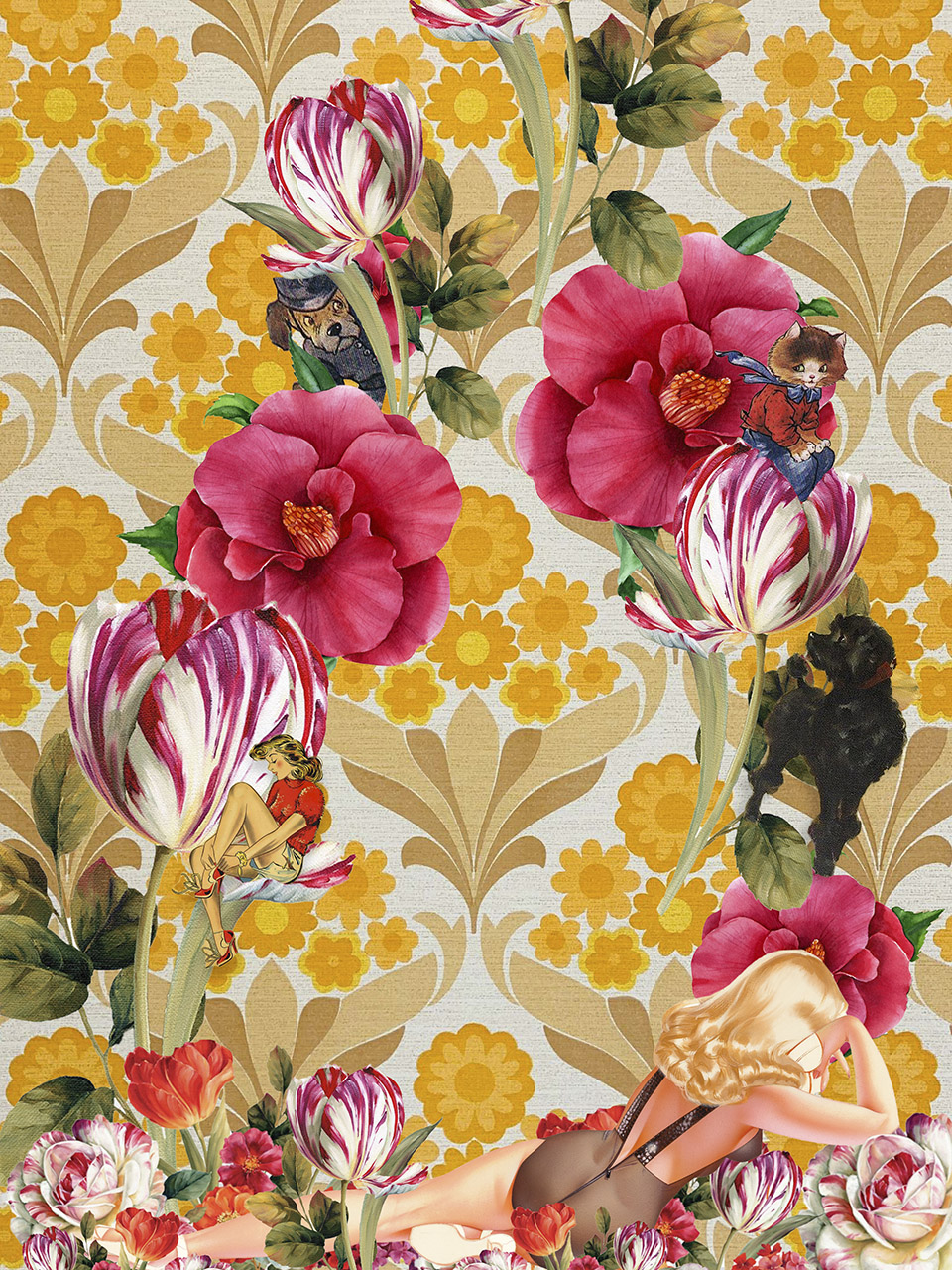
FASHION REFERENCES
ALEXANDER MCQUEEN @alexandermcqueen | www.alexandermcqueen.com
DOLCE & GABBANA @dolcegabbana | www.dolcegabbana.com
FENDI @fendi | www.fendi.com
LOUIS VUITTON @louisvuitton | www.louisvuitton.com
MARC JACOBS @marcjacobs | www.marcjacobs.com
RICK OWENS @rickowensonline | www.rickowens.eu/
SAINT LAURENT @ysl | www.ysl.com
VALENTINO @maisonvalentino | www.valentino.com
Behind the process…




